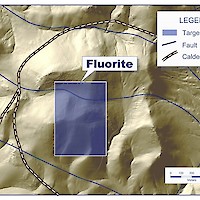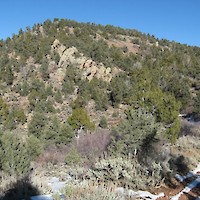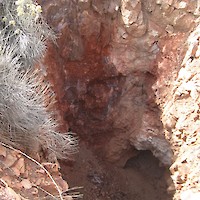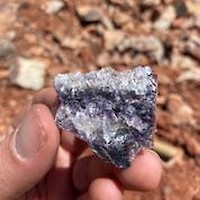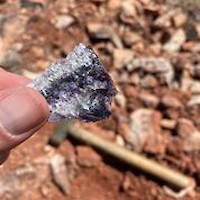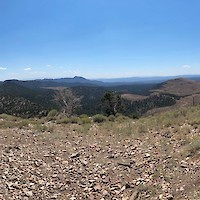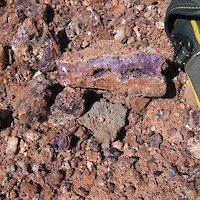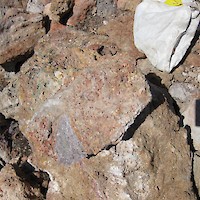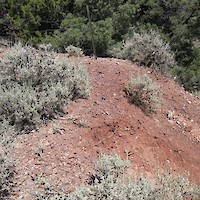System Type:
Epithermal gold system associated with large a structural zone within a rhyolite dome.
Strike-Length:
The Fluorite target has an exposed strike length of 400 meters and a width of 100 meters consisting of a series of historical workings which exploited the high-grade veins.
Resource:
None at this time
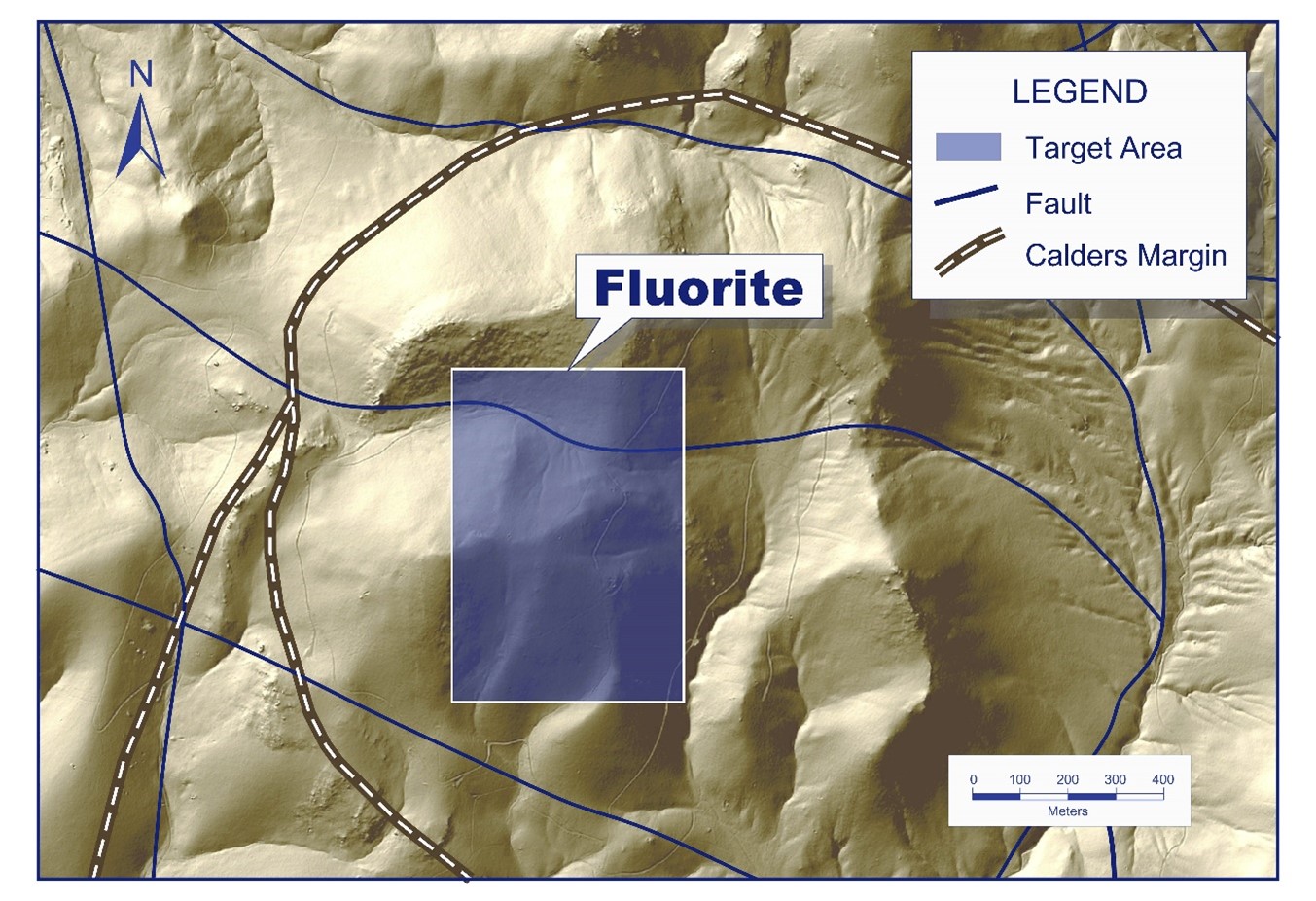
Location:
The Fluorite target is located immediately north of the Pope target within the Gold Springs caldera system, on the Nevada side of the Gold Springs project.
Drilling:
In 2012, The Company completed three drill holes on the Fluortie target. Each hole intercepted the target structure displaying fluorite associated with hematite muds along the margins of a younger latite dike that cut the rhyolite flow dome. The latite dike appears to have a northwest strike and near vertical dip. Gold values from the holes were anomalous with most 1.52 metre intervals in the 0.04-0.09 g/t Au range and a high of 0.5 g/t Au. The drilling showed that these structures continue along strike and at depth but lacked the high-grade gold mineralization observed at the surface.
Geophysics:
Fluorite is situated on a large circular ZTEM (airborne geophysical survey) resistivity anomaly thought to be associated with the rhyolite dome. No CSAMT (ground-based geophysical survey) has been run in this area.
Geology:
The Fluorite target is a resurgent rhyolite dome complex located immediately north of the Pope target within the Gold Springs caldera system (see map above). The target is a large structural zone hosting banded fluorite and associated gold mineralization. Outcrops around the fluorite occurrence display silicified rhyolite with discontinuous, stringer quartz veining carrying gold values up to 1.11 g/t. The Fluorite occurrences are banded with thin seams of hematite clay between bands. When panned these clays seams produce tails of flower gold and samples taken of the fluorite have resulted in assays of up to 23.45 g/t gold.
Locally the rocks exhibit opaline silicification, which is interpreted to be the near-surface expression of an epithermal system. Mineralization at the Fluorite target is unusual and consists of a vertical shaft and a lower adit that explore a fluorite-bearing pipe that cuts the rhyolite and tuffs. The host structure trends northwest, and averages 0.7 to 1.0 metres wide. Mineralization consists of purple and green fluorite, crustiform lattice quartz, and red earthy hematite. The fluorite is concentrically banded, and forms pods up to 2 meters across.
Bull Hill is the historic name for the prominent hill to the north of the Pope Mine and is a resurgent rhyolite dome surrounded by intercalated flows and tuffaceous sediments and tuffs that accumulated within the Gold Springs caldera moat.
Additional geological work is required to better understand the gold mineralization in the Fluorite area. Mineralization appears to be directly associated with the Gold Springs caldera complex and is a distinctly separate style of mineralization than the vein systems observed elsewhere in the district.
Structural Geology:
The Fluorite target is a large structural zone hosting banded fluorite and associated gold mineralization. The South Horseshoe right-lateral strike-slip fault (SHSF) passes through the Fluorite resource. Fluorite structural features suggest right lateral movement with the presence of second order north-south faulting providing good preparation for rocks and mineralization in the area.
Historical Mining:
A few historic workings occur in the area consisting of one shaft and one adit, both developed to exploit the gold-fluorite-bearing zone.
Hosted within the Bull Hill rhyolite intrusive plug, a 0.6 to 0.9 meters wide vein of purple and green fluorite and hematite has been explored through a shaft and an adit with some 275 meters of drifting.
Sampling 25 feet below the collar of the shaft conducted by Perry in 1976 showed the veining contained gold values including 2.66 g/t across 0.6 meters. A grab sample assayed 13.45 g/t of gold for the shaft dump. GRC sampling produces gold values as high as 32.45 g/t with several other samples over 10 g/t.
True thickness is estimated to be 70-100% of reported length. Gold equivalent based on US$1,800/oz gold, US$25/oz silver and 50% for silver recovery.
Geochemistry:
The Fluorite area is known for the ability to pan gold out of the hematite rich clays associated with the fluorite occurrences within the rhyolite dome. Typical gold assays of the fluorite bearing clay range from 7-10 g/t Au with highs of 23.45 g/t. Old trenches have exposed fluorite zones between the shaft and adit which are located 250 metres apart. Samples from these areas produce values of +10 g/t gold. Soil samples across a portion of the target show a discontinuous gold anomaly.
Samples taken of the banded fluorite have graded as high as 23.45 g/t gold. One select sample of the hematite clays returned values of 1.38 g/t Au and 6.5 g/t Silver. Values greater than the resource cut-off grade of 0.25 g/t Au are listed in the table below.
Table: Rock Chip Sampling Results from the Fluorite target:
|
Sample |
Sample Type |
Description |
Au g/t |
Ag g/t |
|
225453 |
Dump |
Banded fluorite with hematite clay seams |
5.66 |
32.4 |
|
225454 |
Dump, Select |
Select sample of hematite clays |
1.38 |
6.5 |
|
33691 |
float |
Narrow fluorite vein |
23.45 |
66.2 |
|
44055 |
Outcrop |
Red Clay cutting fluorite and quartz veining |
>10.00* |
N/A** |
|
44056 |
Outcrop |
Purple fluorite with quartz veins |
>10.00* |
N/A** |
|
44057 |
Outcrop |
Quartz-adularia vein |
>10.00* |
N/A** |
|
44058 |
Outcrop |
Rhyolite with trace of late purple fluorite |
>10.00* |
N/A** |
|
44059 |
Outcrop |
Rhyolite dyke with trace to weak silicification |
1.11 |
N/A** |
|
44060 |
Outcrop |
Quartz eyed rhyolite dyke |
1.71 |
N/A** |
|
44354 |
Mine dump |
Earthy, hematitic gossan coating rhyolite |
8.47 |
40.3 |
|
44355 |
Mine dump |
Banded fluorite, purple, clear with hematite partings |
14.42 |
88.7 |
*Overlimits for these samples were not run. ** Silver not analyzed

